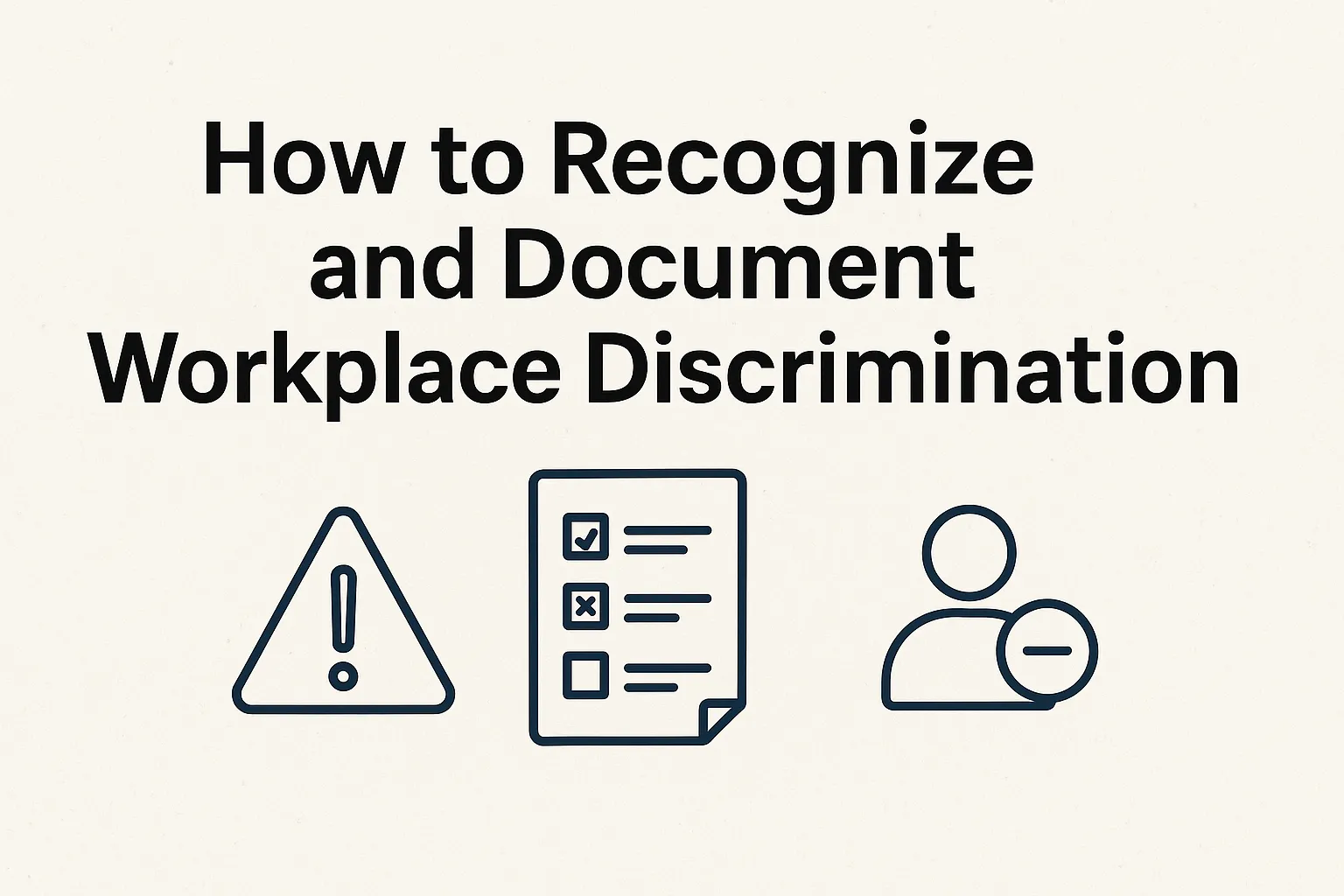How to Recognize and Document Discrimination at Work

Discrimination in the workplace isn’t always loud or obvious. Sometimes, it shows up in quiet patterns — being passed over, excluded, silenced, or judged more harshly than others. If you’re experiencing unfair treatment and aren’t sure what to call it, this guide will help you spot the signs and start building the paper trail you need to protect yourself.
Missed Part 1? Start here: What Is Discrimination in the Workplace?
👀 How to Recognize Discrimination in the Workplace
To recognize workplace discrimination, look at patterns, inconsistencies, and how others are treated in similar situations.
🧠 It’s Not Just About Intent
Discrimination doesn’t require someone to use a slur or announce bias. What matters is the impact — are you being treated differently because of your race, gender, age, religion, or another protected trait?
🔍 Common Signs of Discrimination
| Behavior | What to Watch For |
|---|---|
| Unequal treatment | Colleagues with similar qualifications get better projects, raises, or roles |
| Harassment or jokes | Derogatory comments about your identity, even “just kidding” |
| Being excluded | Left out of meetings, emails, or opportunities without cause |
| Retaliation | Punishment after speaking up or filing a complaint |
| Bias in performance reviews | Evaluations based on personality rather than objective metrics |
“We’re just looking for someone who fits the culture…” is often a red flag, not a reason.
📊 Real-World Example: Gender Bias
Melissa works in IT. She’s one of the top performers on her team. She applies for a lead position, but it’s given to a male colleague with less experience. The reason given? “He’s more of a natural leader.”
Later, Melissa notices she’s left out of key project planning calls. Her suggestions are ignored in meetings. She begins to receive vague feedback like “You need to be more assertive” — without specifics.
This is patterned gender discrimination, and it’s actionable.
📝 Why Documentation Is Your Best Protection
If you suspect you’re experiencing discrimination, start documenting everything — now. Documentation creates a clear record of what’s happening, when, and how it affects you.
“You don’t have to prove intent — you just have to show a pattern of unfair treatment tied to a protected characteristic.”
🗂️ What to Record
Use a notebook, app, or secure digital folder. Keep your records private and off your work device.
| What to Document | Include This Info |
|---|---|
| Date & time | When it happened |
| People involved | Names, titles, and witnesses |
| Description | What was said or done (use quotes if possible) |
| Outcome | What happened as a result (e.g., excluded, warned, demoted) |
| Impact | How it affected your work or well-being |
| Related materials | Emails, screenshots, performance reviews, chat logs |
✍️ Example Entry
April 12, 2025 – 2:00 PM – Zoom Meeting
My manager, Lisa, said I’m “too emotional” to lead client negotiations. This was in response to me raising a concern about timeline issues. John and Priya were on the call. This is the third time in two months Lisa has said something like this. I’ve not received similar feedback in written reviews.
📂 Tips for Effective Documentation
- Keep entries factual and emotion-free — avoid exaggeration
- Record events as soon as they happen
- Back up your notes in the cloud
- Save any written communication related to the issue
- Track patterns, not just one-offs
🎙️ Can You Record Conversations?
That depends on your state. In one-party consent states, you can legally record any conversation you’re part of. In two-party consent states, all participants must agree.
⚠️ Always check local laws and/or with an attorney before recording. This is not legal advice.
🧰 How WorkplaceWitness.AI Can Help You
WorkplaceWitness.AI offers a secure, private platform to document incidents. You can log what happened as soon as it occurs, and each entry is automatically time-stamped and safely stored. The app also prompts you to include key details (such as dates, people involved, and locations) and lets you upload evidence like emails or photos, so all relevant information is organized in one place.
Beyond just keeping records, WorkplaceWitness.AI helps you spot patterns and prepare to take action. It can generate a chronological timeline of your incidents, making it easier to identify repeated behaviors or harassment over time. When you’re ready to act, you can compile your entries into a professional report for HR or an attorney. All your data stays encrypted and under your control until you decide to share it. With this tool, you have a convenient way to build a strong, time-stamped case if you need to.
🔄 What’s Next?
Once you’ve documented enough to see a clear pattern, it’s time to report it — either internally to HR or externally through legal channels.
That’s exactly what we’ll cover in the next post:
👉 How to Report Discrimination in the Workplace (Step-by-Step Guide)
🧠 TL;DR – Key Takeaways
- Discrimination often shows up in patterns, not isolated events.
- Start documenting early — it strengthens your case and memory.
- Save everything: notes, emails, evaluations, quotes, screenshots.
- Be professional, factual, and detailed in your documentation.
- Your documentation can protect you from gaslighting and retaliation.
Stay Updated
Get the latest updates about workplace rights and our app launch.